Launch Vehicles
Launch Vehicles are used to transport and put satellites or spacecrafts into space. In India , the launch vehicles development programme began in the early 1970s. The first experimental Satellite Launch Vehicle (SLV-3) was developed in 1980. Rohini Satellite was launched with its help. In the second stage an augmented version of this, ASLV, was launched successfully in 1992. India has made tremendous strides in launch vehicle technology to achieve self-reliance in satellite launch vehicle programme.
In the third stage Polar Satellite Launch Vehicle (PSLV) was developed in which liquid propellant was used for the first time along with solid propellants. In the fourth stage Geosynchronous Satellite Launch Vehicle (GSLV) was developed. Its second and fourth stage uses cryogenic engines. They use liquid hydrogen as fuel at -253 ° C and liquid oxygen at -183 ° C as oxidizer.
PSLV has repeatedly proved its reliability and versatility by launching 44 satellites /spacecrafts (19 Indian and 25 for international customers) into a variety of orbits so far. ISRO also makes the Rohini series of sounding rockets used by the Indian and international scientific community to launch payloads to various altitudes for atmospheric research and other scientific investigations.
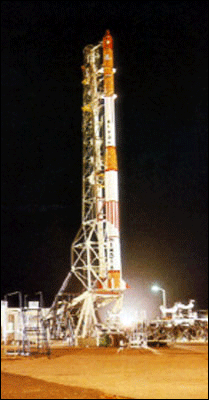 |
SLV-3:Satellite Launch Vehicle-3 (SLV-3), India's first experimental satellite launch vehicle was successfully launched on July 18, 1980 from SHAR Centre Sriharikota, when Rohini satellite, RS-1, was placed in orbit. Typical Parameters of SLV:
|
ASLV: Augmented Satellite Launch Vehicle (ASLV) was developed to act as a low cost intermediate vehicle to demonstrate and validate critical technologies. The strap-on stage consisted of two identical 1m diameter solid propellant motors, Under the ASLV programme four developmental flights were conducted. Typical Parameters of ASLV:
|
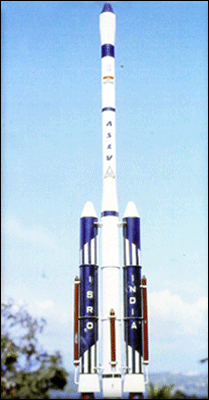 |
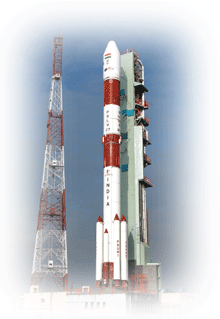 |
PSLV:The Polar Satellite Launch Vehicle , s the first operational launch vehicle of ISRO. PSLV is capable of launching 1600 kg satellites in 620 km sun-synchronous polar orbit and 1050 kg satellite in geo-synchronous transfer orbit. PSLV has four stages using solid and liquid propulsion systems alternately. The first stage is one of the largest solid propellant boosters in the world and carries 139 tones of propellant. A cluster of six strap-on attached to the first stage motor, four of which are ignited on the ground and two are air-lit. The reliability rate of PSLV has been superb. There had been 16 continuously successful flights of PSLV, till July 2010. With its variant configurations, PSLV has proved its multi-payload, multi-mission capability in a single launch and its geosynchronous launch capability. Typical Parameters of PSLV
|
GSLV:Geosynchronous Satellite Launch Vehicle (GSLV)-Mark I&II, is capable of placing INSAT–II class of satellites (2000 – 2,500 kg) into Geosynchronous Transfer Orbit (GTO). GSLV is a three stage vehicle. GSLV is 49 m tall, with 414 t lift off weight. It has a maximum diameter of 3.4 m at the payload fairing. First stage comprises S125 solid booster with four liquid (L40) strap-on. Second stage (GS2) is liquid engine and the third stage (GS3) is a cryo stage. The vehicle develops a lift off thrust of 6573 KN. The first flight of GSLV took place from SHAR on April 18, 2001 by launching 1540 kg GSAT-1. It was followed by four more launches , GSLV-D2 on May 8, 2003 (GSAT-2 1825 kg), GSLV-F01 on September 20, 2004 (EDUSAT 1950 kg), GSLV-F02 on July 10, 2006, GSLV-F04 on September 2, 2007 (INSAT-4CR 2130 kg) and GSLV-D3 on April 15, 2010. Typical Parameters of GSLV - Mark I&II
|
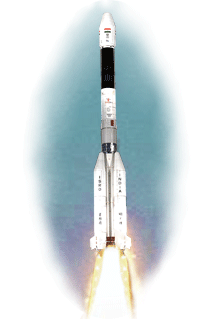 |
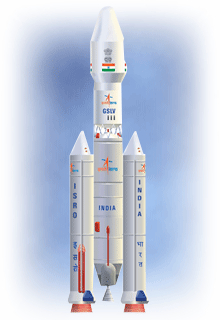 |
Geosynchronous Satellite Launch Vehicle Mark III is a launch vehicle currently under development by the Indian Space Research Organization. GSLV Mk III is conceived and designed to make ISRO fully self reliant in launching heavier communication satellites of INSAT-4 class, which weigh 4500 to 5000 kg. It would also enhance the capability of the country to be a competitive player in the multimillion dollar commercial launch market. The vehicle envisages multi-mission launch capability for GTO, LEO, Polar and intermediate circular orbits. GSLV-Mk III is designed to be a three stage vehicle, with 42.4 m tall with a lift off weight of 630 tones. First stage comprises two identical S200 Large Solid Booster (LSB) with 200 tones solid propellant, that are strapped on to the second stage, the L110 re-startable liquid stage. The third stage is the C25 LOX/LH2 cryo stage. The large payload fairing measures 5 m in diameter and can accommodate a payload volume of 100 cu m. The development work on Mk III is progressing as per schedule for a launch in 2012. Typical Parameters of GSLV Mark III
|
(Source: isro)
